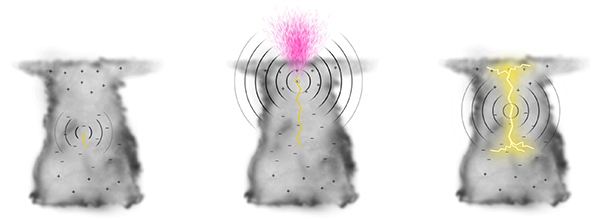Until recent years, the research focus on the high-energy photons known as gamma rays has been on nuclear and cosmic sources for them. Now it has moved to the cloud—the thundercloud, that is—where short bursts of gamma rays, known as terrestrial gamma ray flashes (TGFs) or dark lightning, have been observed. In a thunderstorm, a gamma-ray burst occurs when electrons accelerated by a strong electric field to almost the speed of light collide with air molecules. See also: Electric field; Gamma-ray burst; Gamma rays; Photon; Thunderstorm

In April 2013, Nikolai Østgaard and coworkers reported the first observation linking dark lightning to visible lightning. By chance, two satellites passed close enough over a thunderstorm to record a TGF and visible lightning, while a radio receiver at Duke University in Durham, North Carolina recorded the resulting pulses of radio waves. The sequence of events started with a lightning leader forming in a cloud, which produced a weak radio pulse. Next, a TGF and a strong radio pulse were detected, followed by a bright intracloud lightning flash and another radio pulse. The entire event took about 300 milliseconds, with the TGF lasting 70 microseconds. See also: Lightning; Meteorological instrumentation; Remote sensing
Like normal bright lightning, dark lightning is a mechanism for discharging energy from a thunderstorm. However, dark lightning is a rarer phenomenon. The frequency of TGFs compared to that of bright lighting is largely unknown, with estimates of 1 to 10 TGFs produced per 1000 lightning flashes. A more accurate assessment may be possible after the European Space Agency's Atmosphere Space Interaction Monitor, which includes a gamma-ray detector, is flown to the International Space Station in 2013–2014. Meanwhile, the International Center for Lightning Research and Testing at the Florida Institute of Technology has designed a ground-based experiment, the Thunderstorm Energetic Radiation Array, to measure gamma rays and lightning from thunderclouds. See also: Atmospheric electricity; Storm electricity





